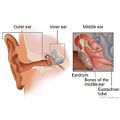Condition Basics
What is swimmer's ear?
Swimmer's ear (otitis externa) is an inflammation or infection of the ear canal, the passage that leads from the outer ear to the eardrum. This condition is called swimmer's ear, because it commonly occurs in people who have been swimming. But other people can get it too.
What causes it?
You can get swimmer's ear when bacteria or fungus grows in your ear canal. This happens when water, sand, or other small debris irritates the delicate skin in the ear canal. Other things that can irritate the ear canal include hearing aids, lots of ear cleaning, and eczema of the ear canal.
Swimmer's ear is more likely if you have a very narrow or hairy ear canal; live in a warm, humid climate; have little or no earwax; have lots of ear infections; or have eczema or dry skin. If you have had swimmer's ear in the past, you are more likely to get it again.
What are the symptoms?
Swimmer's ear can be very painful. The pain can get worse when you touch the earlobe or another part of the outer ear or when you chew. Other symptoms can include itching, a feeling of fullness in the ear, and a yellowish or brownish discharge from the ear. Your ear canal may be swollen. In severe cases, the outer ear can be red and swollen too.
How is it diagnosed?
A doctor can usually tell whether you have swimmer's ear by looking into your ear and asking questions about your symptoms.
How is swimmer's ear treated?
Follow these tips when treating swimmer's ear:
- If your doctor prescribed eardrops, use them as directed.
- Talk with your doctor before putting anything in your ear.
- Avoid getting water in the ear until after the problem clears up.
- Use a hair dryer set on low to carefully dry the ear after you shower.
- Take an over-the-counter pain medicine like acetaminophen (such as Tylenol), ibuprofen (such as Advil or Motrin), or naproxen (such as Aleve). Read and follow all instructions on the label. Do not give aspirin to anyone younger than 20. It has been linked to Reye syndrome, a serious illness.
Some home treatment can help swimmer's ear. But it is important to see a doctor first. If your doctor says it's okay, you can try the following:
- If your ear is itchy, try nonprescription swimmer's eardrops, such as Swim-Ear. Use them before and after swimming or getting your ears wet. Read and follow all instructions on the label, and learn how to insert eardrops safely.
- To ease ear pain, apply a warm washcloth or a heating pad set on low.
- Do not use a heating pad when you are in bed. You may fall asleep and burn yourself.
In severe cases, the ear canal should be carefully cleaned out by an ear specialist. Sometimes, if the ear canal is very swollen, a wick with antibiotic drops will be placed in the ear canal.
Do not use ear candles. They have no proven benefit, and they can cause harm.
How can you prevent it?
You may be able to prevent swimmer's ear.
- Do not scratch or clean the inside of the ear with cotton swabs, bobby pins, your fingernails, or other objects.
- Avoid prolonged use of earplugs and in-ear headphones. Like cotton swabs, these can cause irritation and itching and can plug the ear with wax.
- Keep soap, bubble bath, and shampoo out of the ear canal. These products can cause itching and irritation.
- Keep your ears dry.
- After you swim or shower, shake your head to remove water from the ear canal.
- Gently dry your ears with the corner of a tissue or towel, or use a hair dryer on its lowest setting. Hold the dryer several inches away from the ear.
- Put a few drops of rubbing alcohol or rubbing alcohol mixed with an equal amount of white vinegar in your ears after you swim or shower. You can also use over-the-counter drops, such as Swim-Ear, to help prevent swimmer's ear. Gently wiggle the outside of the ear to let the liquid enter the ear canal. It's important to keep the liquid in the ear canal for 3 to 5 minutes
- Do not swim in dirty or polluted water.

